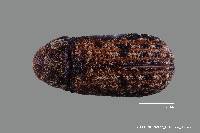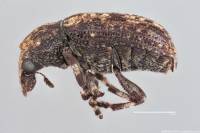Elongate-oval, narrower than lunatus; thorax coarsely and densely punctate; pubescence blackish, with patches and spots of ochraceous and yellowish gray intermixed on thorax and elytra. Head densely punctate, covered densely with ochraceous hairs, beak feebly emarginate at apex; antennae pale, club black, first and second joint stout, second joint much shorter than first, three as long but narrower than the first, four to eight gradually decreasing in length, joints of the club nearly as in lunatus. Thorax slightly broader at base than long, basal carina feebly arcuate, rectangular, recurved at sides, reaching not quite to middle, before the basal angles slightly sinuate; surface coarsely and densely punctate, sparsely pubescent, with blackish brown hairs, intermixed with ochreous spots, especially near apex and at middle of disk. Elytra about two and one·half times as long as the prothorax, striate-punctate, punctures more closely placed and larger than in lunatus, intervals feebly convex and finely and sparsely punctate; pubescence blackish brown, variegated with ochraceous and yellowish grey patches and spots, of which an elongate basal patch is the largest, occupying on each side the second, third and fourth elytral intervals to not quite down the middle, leaving a large acutellar apace and suture darker, third interval aod apex tesselated with some paler spots, sutural interval faintly so. Body beneath sparsely clothed with short greyish pubescence. Legs black, except the tibiae at middle and nearly the entire firstjolnt of middle and hind tibiae pale. Length 6 mm.
Arizona (Dietz).
This species differs from lunatus by narrower form, coarsely and densely punctate prothorax, not being as densely pubescent, and the different markings and general color. In specimens of lunatus from Florida and Texas the white antemedian spot of elytra is entirely absent and the general color is more uniform ochraceous, without any mixture of white ; this gives these specimens a distinct appearance, but as no other character exists to separate them and intermediate specimens occur in the same localities, they do not deserve, in my opinion, a varietal name.
























